
One of the best ways to improve healthcare marketing is to go beyond the theoretical. Seeing what other brands are actually doing well can act as a springboard for a better approach.
Kindred Hospitals has a lot of real-world insights to offer. This massive organization, which offers post-acute, rehab, hospice and home care services across 16 states, is making the most of digital and traditional marketing channels.
Kindred has steep marketing challenges to overcome. Their approach to meeting these challenges will inspire your own healthcare brand– whether it’s large or small.
How are they connecting with their target audience in a time of so much confusion and overwhelming healthcare jargon?
Let’s take a look!
Here are some of the key strategies that have helped Kindred Healthcare market so effectively. Because so many of them use digital tools, they’re adaptable for organizations large and small.
1. Educating and Empowering Patients with Content
Two of the biggest challenges Kindred must overcome are:
Creating a “Resources Center” on their website accomplishes both!
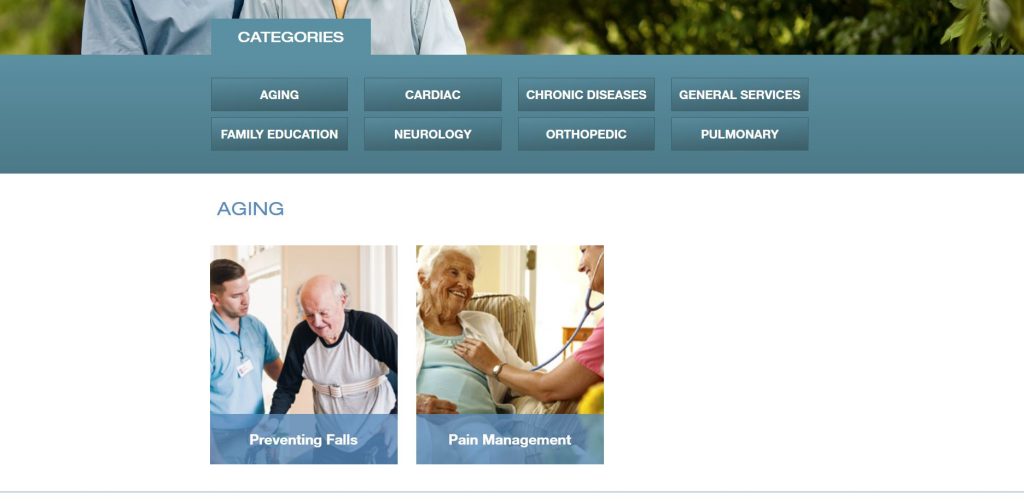
Instead of just listing services (post-acute, home care, rehab, etc.), Kindred resonates with potential patients based on their health conditions. Their content educates potential patients about their condition and empowers them by showing options for treatment, as well as sharing inspiring success stories.
Each health condition– respiratory, cardiac, brain injury, and more– is easy to find, thanks to their intuitive website layout. Kindred also uses simple language to appeal to patients, abandoning “medical textbook” jargon.
2. Tailoring the Messaging to Accommodate Multiple Audiences
Kindred’s marketing challenge is complex because they target two entirely different audiences. On one hand, it’s never been more important to connect with potential patients because they’re taking more active roles during the process. But they also need to resonate with providers and case managers for hospitals and healthcare systems: vital referral sources.
Kindred includes a special section within its Resources section called “Healthcare Professionals” designed to specifically target the latter group:
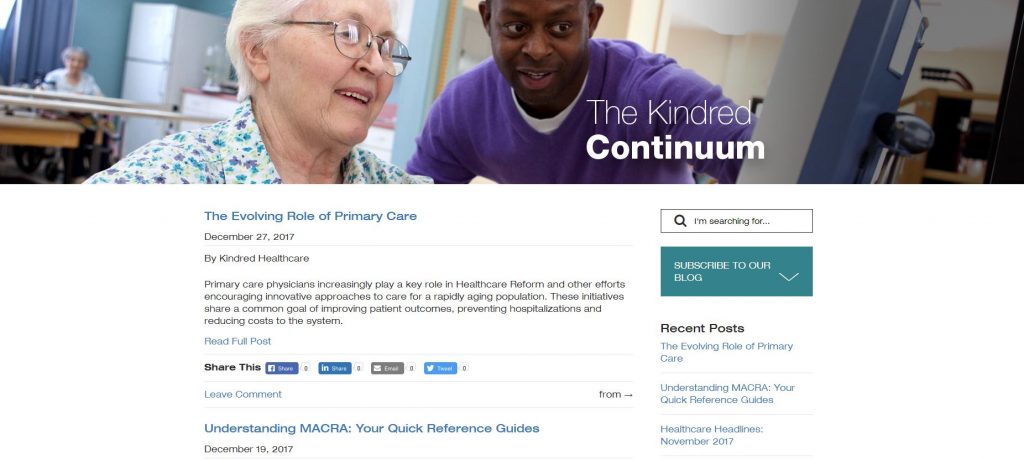
One thing you’ll notice right away: the content here is much different than patient-oriented resources. There is more medical jargon. It’s quick hits designed for time-strapped professionals.
Kindred knows these people are incredibly busy. But they still create value by writing Reader’s Digest style posts, quick reference guides, and highlights of the latest developments.
This strategy helps Kindred connect with these key gatekeepers on their own terms. Busy providers and case managers can read the latest updates at their leisure instead of dealing with annoying interruptions during the workday.
Even if your brand is much smaller, it’s crucial to adapt your messaging to fit every audience you’re trying to reach. Fortunately, thanks to digital tools like automation and email list segmentation, there are plenty of cost-effective ways to do this.
3. Blogging to Build Relationships, Credibility, and Trust
The Kindred website also features a patient-oriented blog:
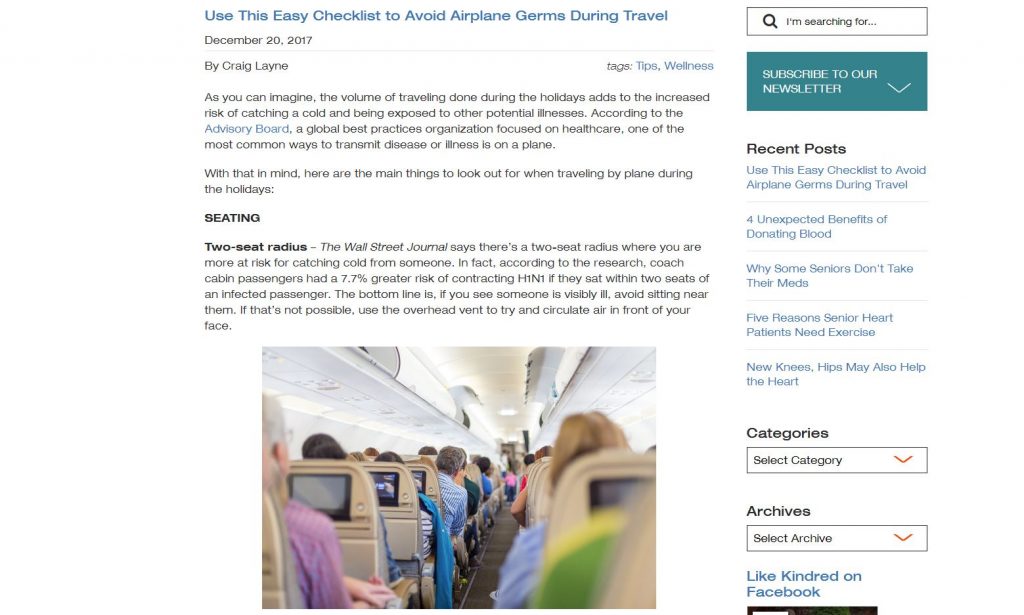
Focusing on information that potential patients find valuable builds a deeper connection.
Kindred’s blog reveals that they care about people, not just the bottom line. Blog topics range from wellness and prevention, all the way to follow-up and coping with the death of a loved one. The broad scope works well. Many people will read Kindred’s content well before becoming a patient. This gives the brand time to establish authority and trust.
Many of Kindred’s blog posts are reprints of content from other reputable sources – like Harvard Health and Cleveland Clinic. By associating with reputable sources, Kindred builds their own reputation.
A blog can adapt well to smaller brands too. Even if you don’t have a lot of time or money for content, you can summarize the latest health developments and find ways to educate your audience. This virtual relationship-building is effective for small brands because, once it’s written, a blog post can scale to huge audiences. And, without the brand recognition of Humana or Mayo Clinic, establishing credibility is even more important.
4. Fostering Conversations on Social Media
Kindred Healthcare uses social media to share patient stories, build community, and humanize the brand. There’s no emphasis on getting as many patients in the door as possible. Instead, it’s all about conversations and sharing.
Twitter is a great platform for them to share patient success stories, like this one of a patient with H1N1 named Mark:
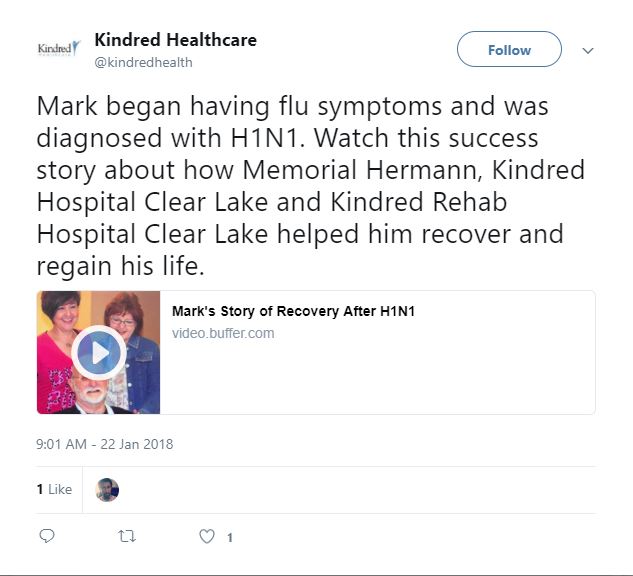
You’ll find plenty more of these as you scroll through Kindred’s Twitter timeline. There’s crossover appeal between their two audiences (providers and patients) because the stories highlight how primary care and post-acute care facilities work together to improve patients’ lives.
There’s also a mixture of health news and wellness tips, which create opportunities to link back to the Kindred blog. Instead of coming up with all these on their own, smaller brands can curate content from other sources and serve as a portal of useful information.
Kindred’s Instagram focuses more on the “human side” of their employees. Take a look at this employee spotlight post of Teresa, an RN in Texas:
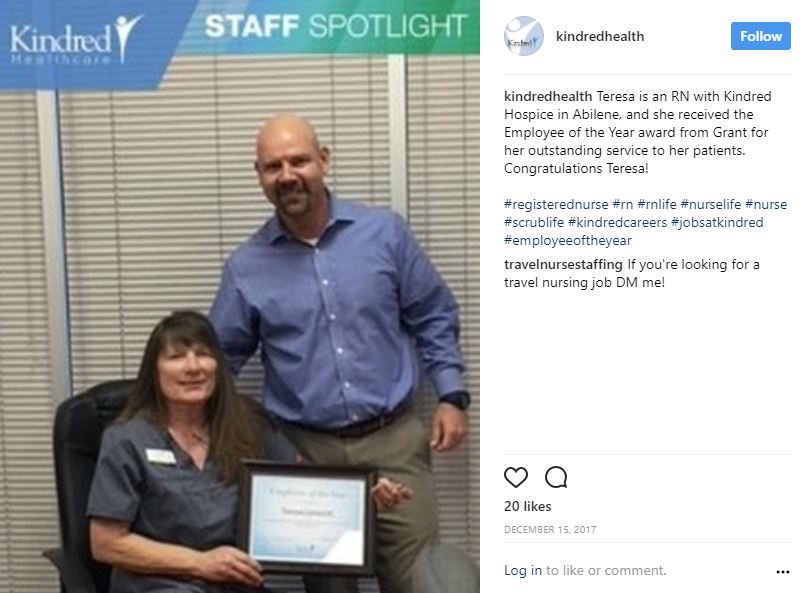
Content like this is great for unveiling the people behind the scrubs and reception desks. It shows that they’re empathetic, motivated, and most importantly, human.
5. Merging Digital and Traditional Marketing Efforts
Kindred traditionally relied on clinical liaison teams to call potential referral sources and meet with them in-person. The challenge was figuring out how to use those limited resources to grow effectively.
Now Kindred is taking advantage of digital marketing tools like CRM software and email marketing automation. They’re using data and surveys to figure out what people want to hear about and stay in touch with them automatically. These tools offer the scale and reach they can’t find anywhere else
This doesn’t mean Kindred has abandoned traditional strategies. Now, they’re using audience data to help make the most of their in-person resources. Feedback from digital tools help their liaisons know whom to focus on and how to appeal to them.
Smaller brands can do this too. By embracing a multichannel marketing approach, we can connect with people more effectively. We can hold on to traditional strategies that work– and use digital to make them even better!
Kindred Hospitals is immense. Their sheer size creates complex marketing challenges they’ve had to overcome.
By studying how they’ve overcome them, we can be inspired by new ideas and tweak our approach. Even smaller brands, with the help of the right marketing partner, can adapt Kindred’s strategies to serve their unique audience.
